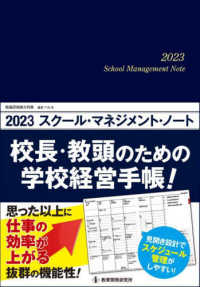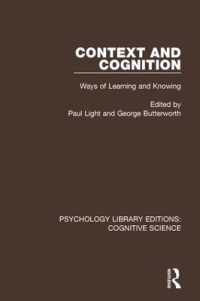- ホーム
- > 洋書
- > 英文書
- > History / World
Full Description
This wide-ranging study uses historical and archaeological evidence to consider humanity's interactions with the environment, fashioning agricultural, gardening and horticultural regimes over a millennium and a half. The discussions of archaeological finds of seeds from discarded rubbish including animal fodder and bedding show the wide range of wild species present, as well as cultivated and gathered plants in the diet of inhabitants and livestock. Pollen analyses, and studies of wood, mosses, and beetles, alongside a look at the local natural environment, and comparison with medieval written records give us a tantalizing picture of early Winchester. The earliest record is by Ælfric of Eynsham in his 11th-century Nomina Herbarum. From medieval records come hints of gardens within the city walls, and considerable detail about agriculture and horticulture, and produce brought into the city. Wild fruit and nuts were also being gathered from the countryside for the town's markets and mills. At St Giles' Fair exotic imported spices and fruits were also sold. All these sources of evidence are brought together to reveal more fully the roles of agriculture and the environment in the development of Winchester.
Contents
Preface ;
I: Introduction and Environment ;
1. Introduction - Martin Biddle, Jane M. Renfrew with contributions by Francis J. Green and Patrick Ottaway ;
2. The Natural Environment of the Winchester Region - Jane M. Renfrew and Patrick Ottaway ;
II: The Written Evidence ;
3. Aelfric's Nomina Herbarum and the Plant Remains from Anglo-Saxon Winchester - Debby Banham ;
4. Agriculture and the Use of Plants in Medieval Winchester: the Documentary Evidence - Derek J. Keene ;
5. Gardens in Medieval and Later Winchester: the Castle, Wolvesey Palace and Eastgate House - Beatrice Clayre and Martin Biddle ;
6. Field Crops and their Cultivation in Hampshire, 1200-1350, in the Light of Documentary Evidence - Jan Z. Titow ;
III: The Archaeological Evidence ;
7. Pollen Analysis of Archaeological Deposits in Winchester - Erwin Isenberg and Jane M. Renfrew ;
8. The Identification and Utilization of Wood in Early Winchester - Suzanne Keene ;
9. The Roman Plant Remains - Peter Murphy ;
10. The Plant Economy and Vegetation of Anglo-Saxon Winchester - Michael Monk ;
11. Plant Remains and Agriculture in Norman and Later Medieval Winchester - Francis J. Green ;
12. Roman and Post-Roman Moss from Lower Brook Street Moss - Dorian Williams and Jane M. Renfrew ;
13. Insect Fauna from Lower Brook Street - Peter J. Osborne ;
14. Conclusion - Patrick Ottaway ;
Concordance of Samples ;
Index 1: General Index ;
Index 2: Insects and Plants








